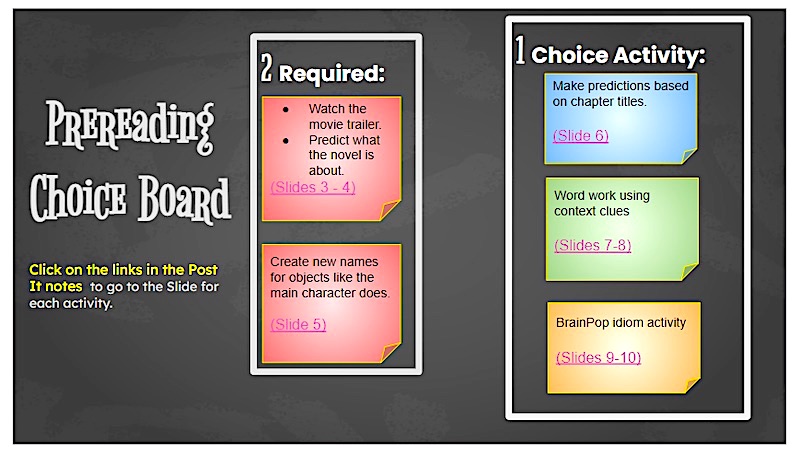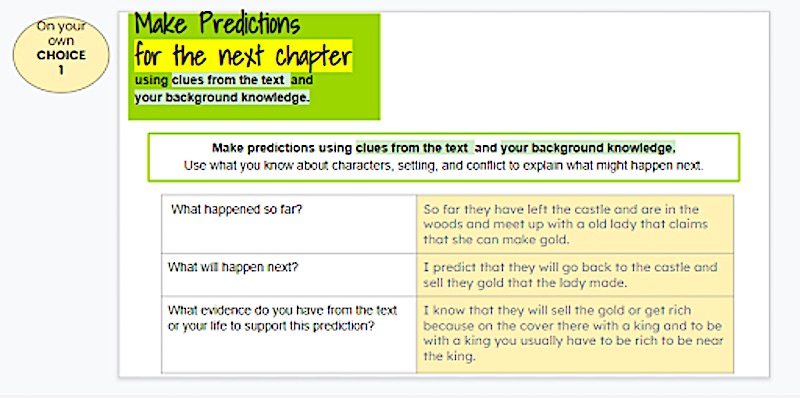One Size Doesn’t Fit All: Choice Boards Can!
 By Kelly Owens
By Kelly Owens
Have you seen the excitement in the cafeteria line at your school? Some clamor for chicken patties, a few for fancy fries, and others eye salads or subs.
Here’s food for thought: Spark similar excitement in the classroom with the power of choice using Choice Boards.
This or That? It’s Fun to Choose!
Variety is the spice of life, they say. Restaurant menus please every palate and food sensitivity. Shoe store shelves feature rows of style options. Libraries house volumes in tons of genres. This or that? Having choices is exciting and empowering!
It’s fun to decide what fits our own interests, strengths, and learning styles. Shake things up in your differentiated classroom by offering students choice via Choice Boards, Unit Menus, and Tic-Tac-Toe boards. (You can choose what you want to call these pretty similar tools.)
What Are Choice Boards?
Choice Boards are exactly like they sound. They are graphic “boards” that show students the choices they have to demonstrate their learning. Students choose how they want to engage with content for the same expected learning outcome. The added perk is the motivational option of choice.
Students take ownership for their own learning when they choose how to engage with content. Choice Boards can offer the skill reinforcement or extension that follows explicitly taught instruction. For teachers of differentiated classrooms, Choice Boards can appeal to different learning styles and address multiple intelligences. Students may be more focused and invested in their learning process when they know they picked their path.
(Click each image below to enlarge.)
Some teachers may use choice boards for asynchronous learning. They can be adapted for remote learning. The Google Slide above allows students to click on the links to take them directly to the choice activities.
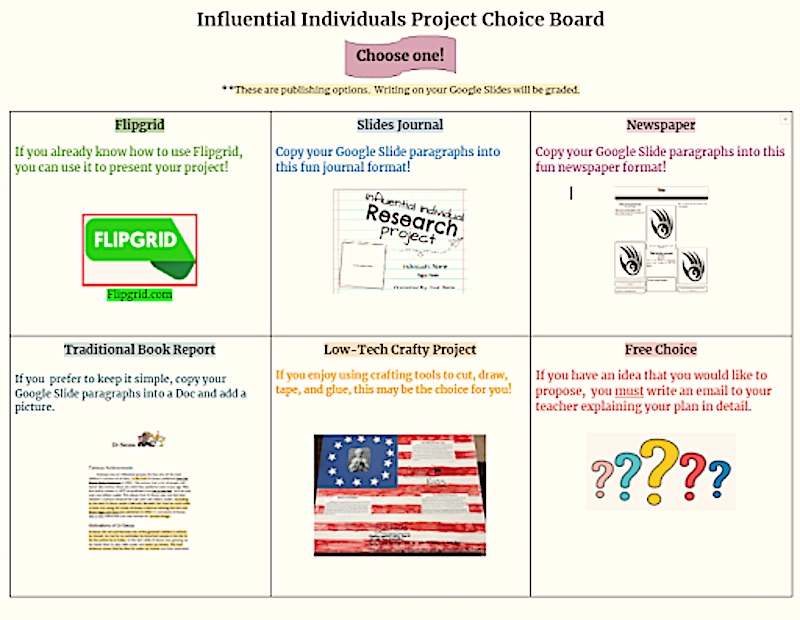
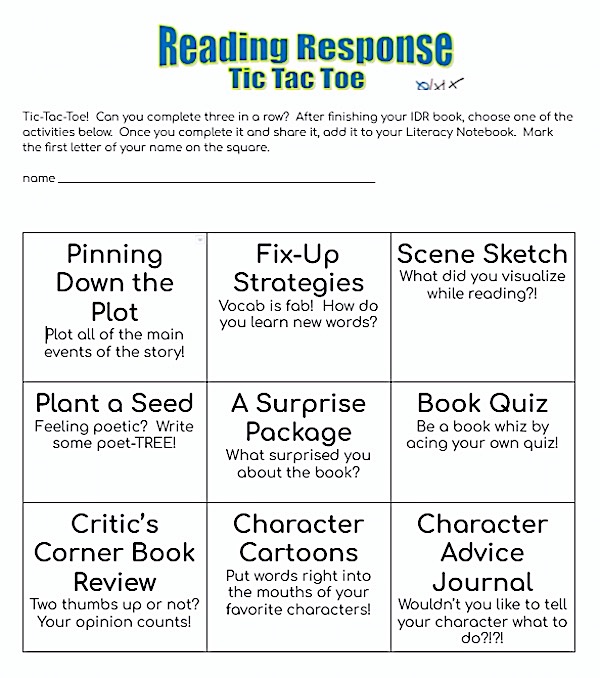
You DON’T Have to Recreate the Wheel!
On paper, computerized, a one-day project, a long-term project – spinning wheels, boxed bullet lists, bingo cards – the possibilities are endless.
As my extraordinary colleague Karen Raia often notes, old things can become new when we repackage them differently. “Same gift, different package.” Repurpose some of the assignments or center activities you have already created.
By packaging choices in a colorful and creative choice board format, the student appeal amps up a level. Use the same rubric to assess the various choice assignments, since they should all show understanding of the same learning intention. There is more than one way to reach the same goal.
I find choice boards help jazz up dry topics, like grammar. Shhhh! The skills are still there in the choice board…just hidden. It’s sort of like disguising broccoli with melted cheese for the cruciferous-shy. When students are given the power to choose how to show their learning, it seems more inviting.
Sure, it may initially involve a bit more instructional planning to develop a few different ways students can demonstrate learning of a skill. But think of that upfront planning time as an investment. The payoff is more focused, motivated, and engaged students during the lesson later.
5 Reasons to Use a Choice Board
1. Choice is motivating
Students enjoy the freedom of selecting their own learning adventures. When I conference with students about their choice assignments, I try to use language that reminds them they are in the driver’s seat. That way they are reminded they chose it and I’m there to support them.
2. Choice is empowering
Choice Boards make learning opportunities visible. Students can see the expectations explicitly presented. When students finish, they can check off completed tasks or cross out Tic-Tac-Toe three-in-a-row, adding to the satisfaction of completion.
3. Choice is appealing to different learning styles
Just like required assignments, choice learning tasks should be designed to follow best practices and meet standards-aligned learning goals. Options can offer a mix of visual, auditory, and kinesthetic modalities. Multisensory learning employs different senses to build greater connections to learning.
4. Choice builds accountability and independence
Students take more ownership for their own learning when they have opportunities to select their learning tasks. There are social emotional learning (SEL) benefits, too. Involving students in the decision making promotes students’ choice and voice. When a teacher offers choice, it hands more responsibility to the student.
5. Choice is adaptable to anything
The design is really up to you. Choice Boards can be paper-based, computer-based, or a combination. Use them for one lesson, a project, or a unit. Decide on a purpose. Do you want to include skill review and reinforcement activities and/or extension choices? The choice is yours!
Design Considerations
- Identify the learning goal.
- Match an assessment rubric to the learning goal.
- Plan explicit teaching of the skill you will provide in addition to Choice Board options.
- Determine which activities will be required and which allow for choice.
- Appeal to different learning styles by providing multisensory choices.
- Consider your students’ skill levels, interests, and levels of readiness.
- Vary levels of complexity and mediums students can use to demonstrate learning.
- Explore what activities you already have that can be repurposed to a Choice Board.
- Decide on the time frame for completion of Choice Board activities.
Readers who chose to reflect on their reading with Choice 1 wrote about their predictions in sentences organized in a chart.
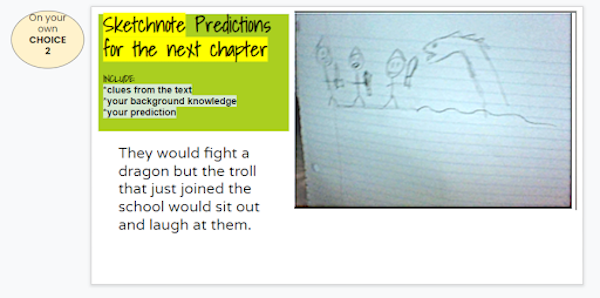
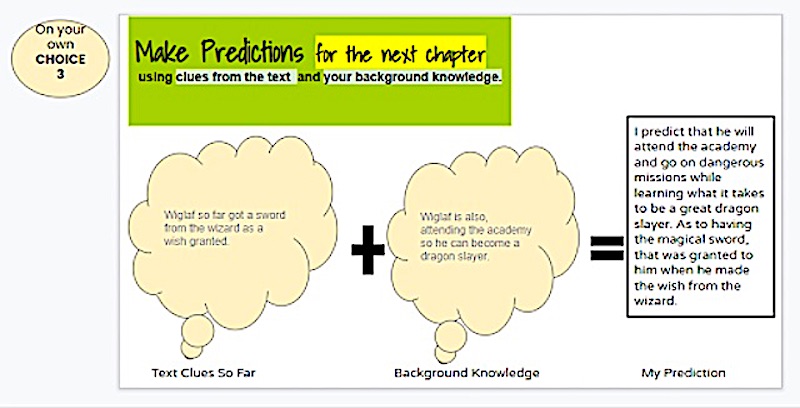
The Choice Board Experience
Part of the fun of Choice Boards is seeing which choices students pick. Just when I predict an art enthusiast will choose to create sketchnotes or comic strips – surprise, they venture out and explore something new instead. Giving students the power to choose is important for young students. As they get older, they will be faced with more choices.
Helping them through their decision making process and supporting them as they follow through on their selections is part of the Choice Board experience. To adults, who make countless choices a day, it might seem insignificant. However, Choice Boards allow students to practice time management, planning, and decision making – all skills they will need as independent decision makers in the future.
Kelly Owens is a literacy teacher who helps sixth grade readers and writers overcome past literacy struggles by building stamina, confidence, and a greater love of learning. As a teacher with over 27 years’ experience, she has proudly represented Hillsborough Township Public Schools as a NJ Governor’s Teacher of the Year. She also co-created Buddies for the Birds, which was featured on Emmy Award-winning Classroom Close-up NJ. Kelly earned her Ed.M. from Rutgers University. Additional writing credits include published work with The King School Series (Townsend Press), The Mailbox magazine, and MiddleWeb.

